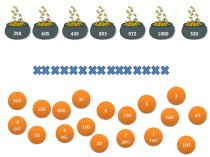- Главная
- Разное
- Бизнес и предпринимательство
- Образование
- Развлечения
- Государство
- Спорт
- Графика
- Культурология
- Еда и кулинария
- Лингвистика
- Религиоведение
- Черчение
- Физкультура
- ИЗО
- Психология
- Социология
- Английский язык
- Астрономия
- Алгебра
- Биология
- География
- Геометрия
- Детские презентации
- Информатика
- История
- Литература
- Маркетинг
- Математика
- Медицина
- Менеджмент
- Музыка
- МХК
- Немецкий язык
- ОБЖ
- Обществознание
- Окружающий мир
- Педагогика
- Русский язык
- Технология
- Физика
- Философия
- Химия
- Шаблоны, картинки для презентаций
- Экология
- Экономика
- Юриспруденция
Что такое findslide.org?
FindSlide.org - это сайт презентаций, докладов, шаблонов в формате PowerPoint.
Обратная связь
Email: Нажмите что бы посмотреть
Презентация на тему Equivalence class testing technique training
Содержание
- 2. AgendaIntroductionTechniqueExamplesApplicability and LimitationsSummaryPracticeReferences
- 4. IntroductionWhat is equivalence class testing? What is
- 5. Introduction: SituationWe are writing a module for
- 6. Introduction: CoverageShould we test the module for
- 7. Introduction: Solution 1If (applicantAge == 0) hireStatus="NO";If
- 8. Introduction: Let’s believe
- 9. Introduction: Solution 2If (applicantAge >= 0 &&
- 10. Introduction: BenefitsUsing the equivalence class approach, we
- 11. Introduction: DefinitionAn equivalence class consists of a
- 12. Introduction: AssumptionsSpecifically, we would expect that:If one
- 13. Introduction: Solution 3If (applicantAge >= 0 &&
- 14. Introduction: Ready?Now, are we ready to begin
- 15. Technique
- 16. Technique: Steps1. Identify the equivalence classes. 2.
- 17. Technique: ContinuousContinuous equivalence classesFor a valid input
- 18. Technique: DiscreteDiscrete equivalence classesFor a valid input
- 19. Technique: ArraySingle selection equivalence classes For a
- 20. Technique: ArrayMultiple selection equivalence classWhile the rule
- 21. Technique: ContradictionsBut, if this were a list
- 22. Technique: CombinationRarely we will have the time
- 23. Technique: All invalidA test case of invalid
- 24. Technique: One invalidIn many cases, errors in
- 25. Technique: Varying valuesFor additional warm and fuzzy
- 26. Technique: TipsAnother approach to using equivalence classes
- 27. Examples
- 28. Examples: 1No invalid choices.It reduces the number
- 29. Examples: 2Input to this field can be
- 30. Examples: 3The valid symbols are {A, AA,
- 31. Examples: 4Rarely will we create separate sets
- 32. Applicability and Limitations
- 33. Applicability and LimitationsEquivalence class testing can significantly
- 34. Applicability and LimitationsVery often your designers and
- 35. Summary
- 36. SummaryEquivalence class testing is a technique used
- 37. Practice
- 38. PracticeZIP Code – five numeric digits.Last Name
- 39. Practice: Answers 1ZIP Code – five numeric
- 40. Practice: Answers 2Last Name – one through
- 41. Practice: Answers 3User ID – eight characters
- 42. Practice: Answers 4Student ID – eight characters.
- 43. Practice: Answers 5
- 44. References
- 46. Скачать презентацию
- 47. Похожие презентации
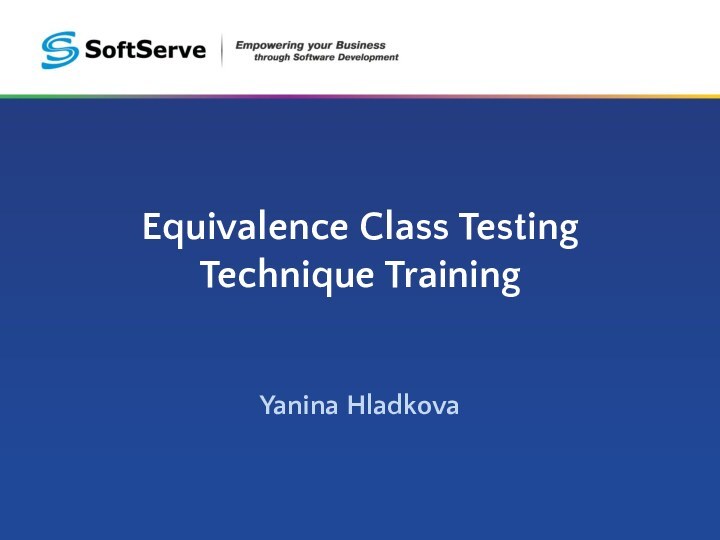







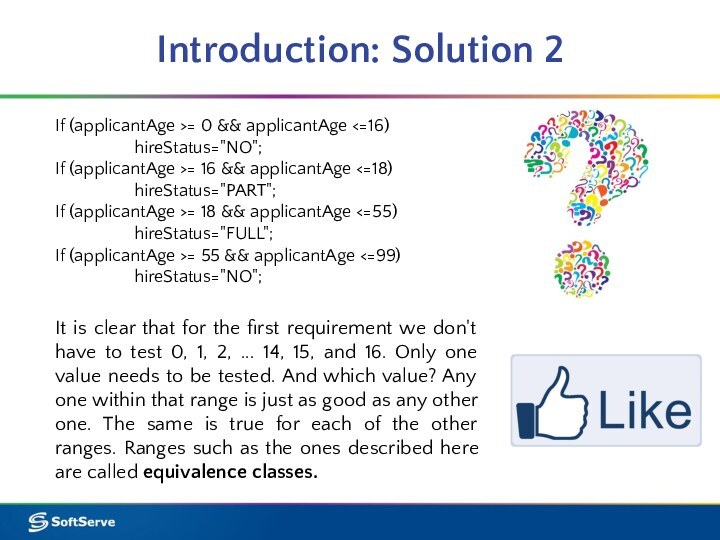
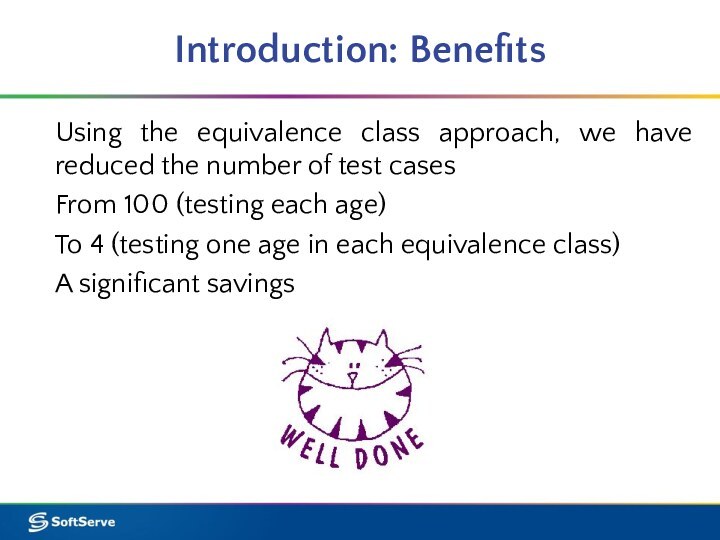
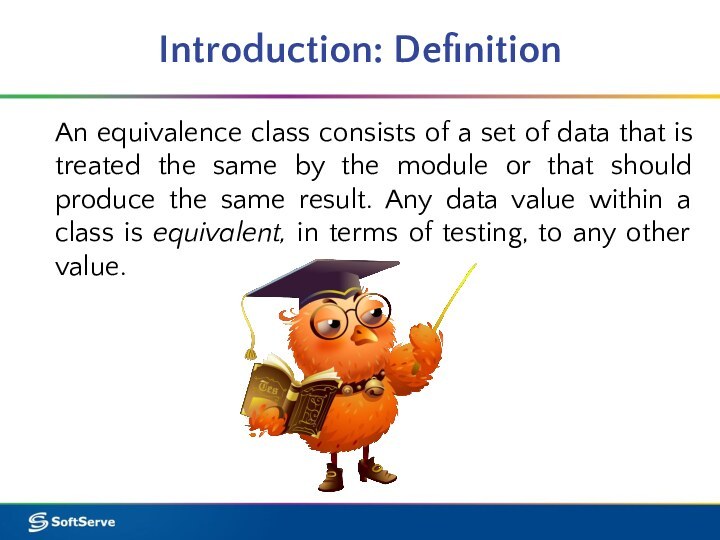





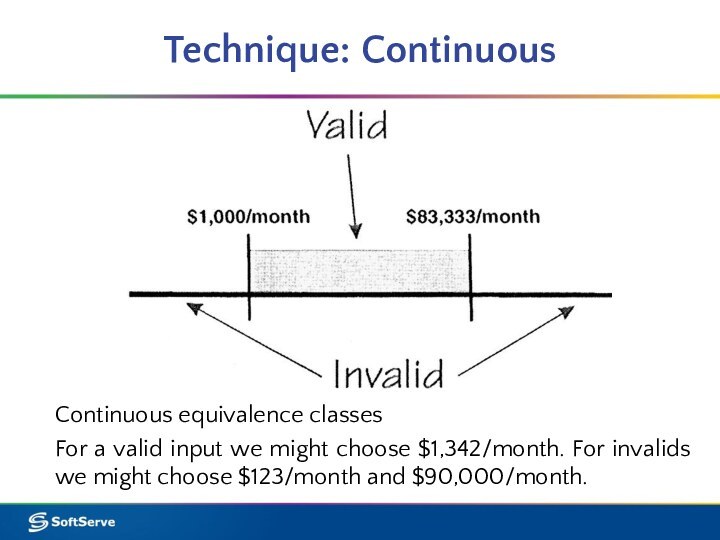
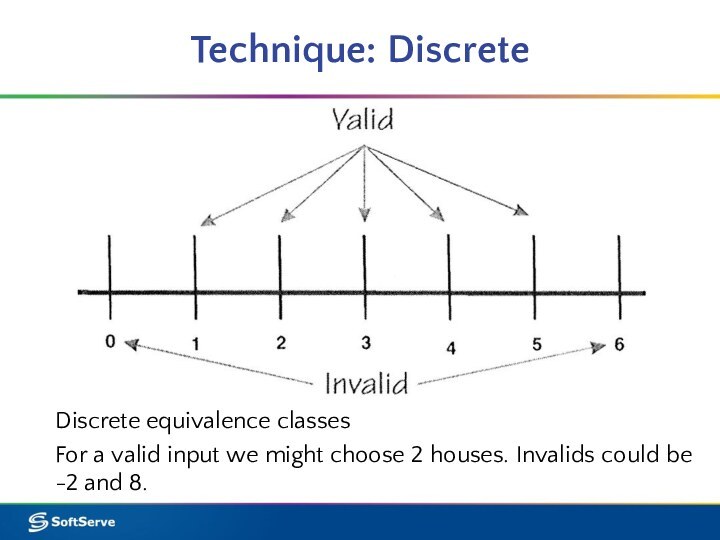



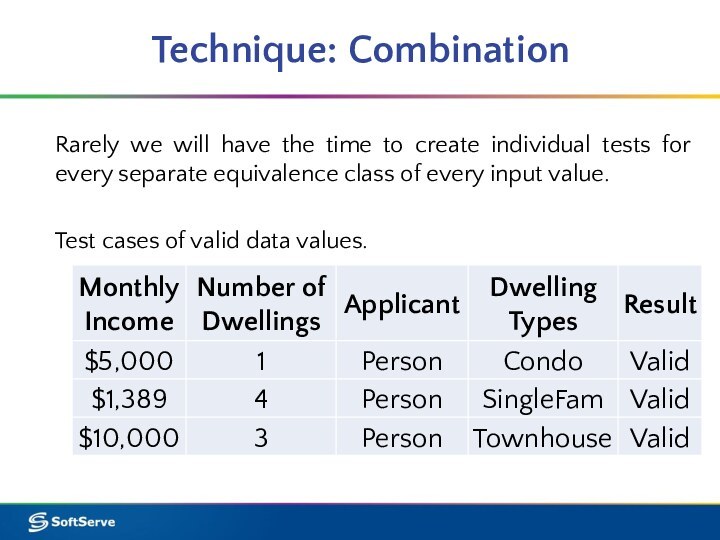



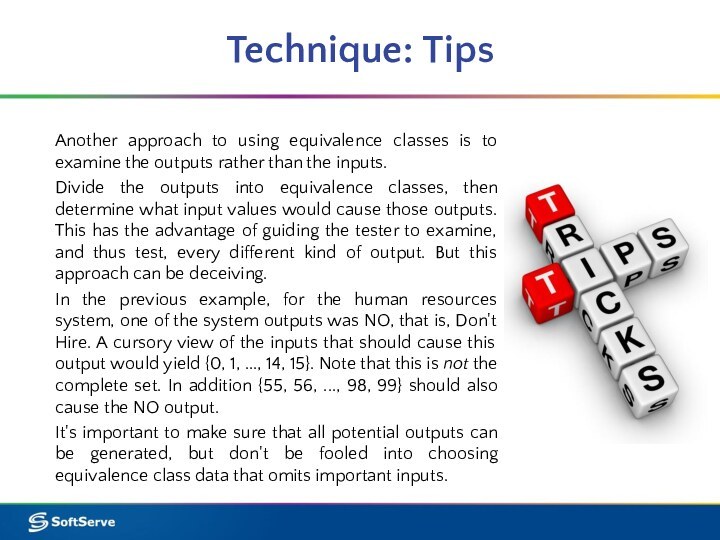



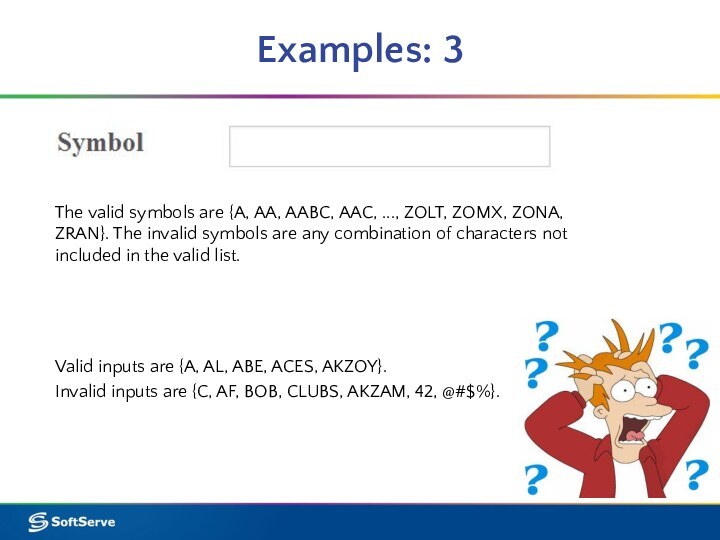
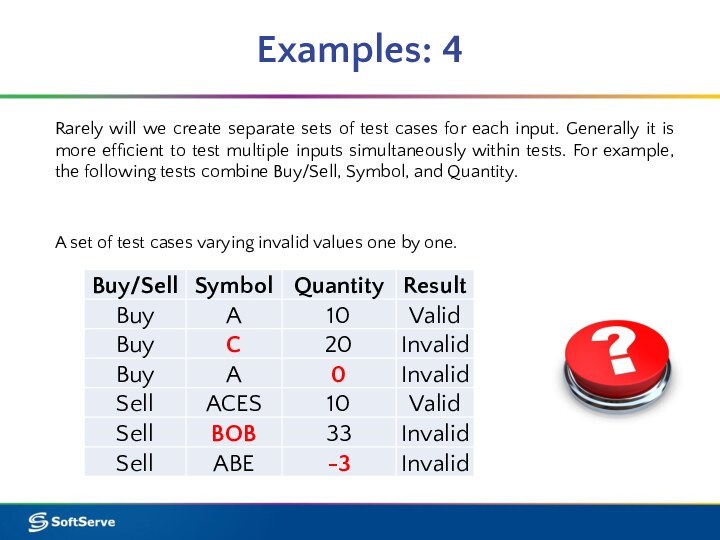

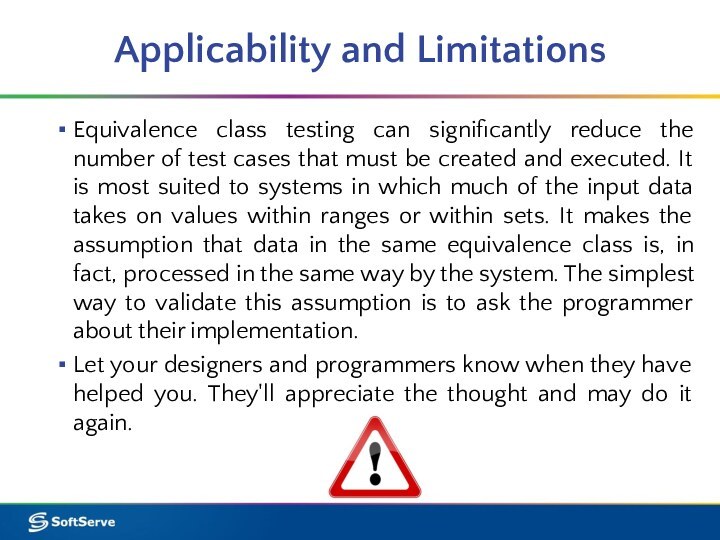





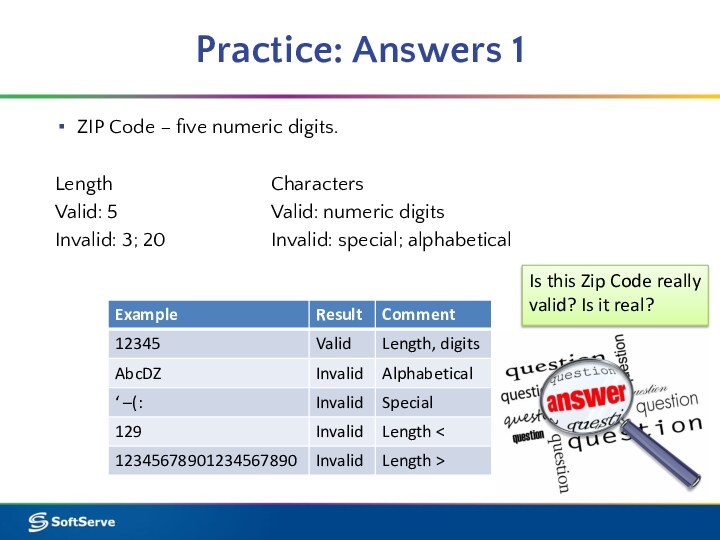







Слайд 4
Introduction
What is equivalence class testing?
What is it used
for?
the number of test cases to a manageable level while still maintaining reasonable test coverage.
Слайд 5
Introduction: Situation
We are writing a module for a
human resources system that decides how we should process
employment applications based on a person's age. Our organization's rules are:0-16 – Don't hire
16-18 – Can hire on a part-time basis only
18-55 – Can hire as a full-time employee
55-99 – Don't hire
Слайд 6
Introduction: Coverage
Should we test the module for the
following ages: 0, 1, 2, 3, 4, 5, 6,
7, 8, ..., 90, 91, 92, 93, 94, 95, 96, 97, 98, 99?If we had lots of time (and didn't mind the mind-numbing repetition and were being paid by the hour) we certainly could.
100 values
Слайд 7
Introduction: Solution 1
If (applicantAge == 0) hireStatus="NO";
If (applicantAge
== 1) hireStatus="NO";
…
If (applicantAge == 15) hireStatus="NO";
If (applicantAge ==
16) hireStatus="PART";If (applicantAge == 17) hireStatus="PART";
If (applicantAge == 18) hireStatus="FULL";
If (applicantAge == 19) hireStatus="FULL";
…
If (applicantAge == 53) hireStatus="FULL";
If (applicantAge == 54) hireStatus="FULL";
If (applicantAge == 55) hireStatus="NO";
If (applicantAge == 56) hireStatus="NO";
…
If (applicantAge == 98) hireStatus="NO";
If (applicantAge == 99) hireStatus="NO";
Any set of tests passes tells us nothing about the next test we could execute. It may pass; it may fail.
Слайд 9
Introduction: Solution 2
If (applicantAge >= 0 && applicantAge
If (applicantAge >= 16 && applicantAge <=18)
hireStatus="PART";
If (applicantAge >= 18 && applicantAge <=55)
hireStatus="FULL";
If (applicantAge >= 55 && applicantAge <=99)
hireStatus="NO";
It is clear that for the first requirement we don't have to test 0, 1, 2, ... 14, 15, and 16. Only one value needs to be tested. And which value? Any one within that range is just as good as any other one. The same is true for each of the other ranges. Ranges such as the ones described here are called equivalence classes.
Слайд 10
Introduction: Benefits
Using the equivalence class approach, we have
reduced the number of test cases
From 100 (testing each
age) To 4 (testing one age in each equivalence class)
A significant savings
Слайд 11
Introduction: Definition
An equivalence class consists of a set
of data that is treated the same by the
module or that should produce the same result. Any data value within a class is equivalent, in terms of testing, to any other value.
Слайд 12
Introduction: Assumptions
Specifically, we would expect that:
If one test
case in an equivalence class detects a defect, all
other test cases in the same equivalence class are likely to detect the same defect.If one test case in an equivalence class does not detect a defect, no other test cases in the same equivalence class is likely to detect the defect.
Слайд 13
Introduction: Solution 3
If (applicantAge >= 0 && applicantAge
= 16 && applicantAge
If (applicantAge >= 18 && applicantAge <=41) hireStatus="FULL";
// strange statements follow
If (applicantAge == 42 && applicantName == "Lee")
hireStatus="HIRE NOW AT HUGE SALARY";
If (applicantAge == 42 && applicantName <> "Lee")
hireStatus="FULL";
// end of strange statements
If (applicantAge >= 43 && applicantAge <=55) hireStatus="FULL";
If (applicantAge >= 55 && applicantAge <=99) hireStatus="NO";
Слайд 14
Introduction: Ready?
Now, are we ready to begin testing?
Probably not.
What about input values like 969, -42,
FRED, and &$#!@? Should we create test cases for invalid input? The answer is, as any good consultant will tell you, "it depends“.
Слайд 16
Technique: Steps
1. Identify the equivalence classes.
2. Create
a test case for each equivalence class.
You could
create additional test cases for each equivalence class if you have time and money. Additional test cases may make you feel warm and fuzzy, but they rarely discover defects the first doesn't find.
Слайд 17
Technique: Continuous
Continuous equivalence classes
For a valid input we
might choose $1,342/month. For invalids we might choose $123/month
and $90,000/month.
Слайд 18
Technique: Discrete
Discrete equivalence classes
For a valid input we
might choose 2 houses. Invalids could be -2 and
8.
Слайд 19
Technique: Array
Single selection equivalence classes
For a valid
input we must use "person." For an invalid we
could choose "corporation" or "trust" or any other random text string. How many invalid cases should we create? We must have at least one; we may choose additional tests for additional warm and fuzzy feelings.
Слайд 20
Technique: Array
Multiple selection equivalence class
While the rule says
choose one test case from the valid equivalence class,
a more comprehensive approach would be to create test cases for each entry in the valid class. That makes sense when the list of valid values is small.
Слайд 21
Technique: Contradictions
But, if this were a list of
the fifty states, and the various territories of the
United States, would you test every one of them? What if in the list were every country in the world?The correct answer, of course, depends on the risk to the organization if, as testers, we miss something that is vital.
Слайд 22
Technique: Combination
Rarely we will have the time to
create individual tests for every separate equivalence class of
every input value.Test cases of valid data values.
Слайд 23
Technique: All invalid
A test case of invalid data
values.
If the system accepts this input as valid, clearly
the system is not validating the four input fields properly. If the system rejects this input as invalid, it may do so in such a way that the tester cannot determine which field it rejected. For example: ERROR: 653X-2.7 INVALID INPUT
Слайд 24
Technique: One invalid
In many cases, errors in one
input field may cancel out or mask errors in
another field so the system accepts the data as valid. A better approach is to test one invalid value at a time to verify the system detects it correctly.A set of test cases varying invalid values one by one.
Слайд 25
Technique: Varying values
For additional warm and fuzzy feelings,
the inputs (both valid and invalid) could be varied.
A
set of test cases varying invalid values one by one but also varying the valid values.
Слайд 26
Technique: Tips
Another approach to using equivalence classes is
to examine the outputs rather than the inputs.
Divide
the outputs into equivalence classes, then determine what input values would cause those outputs. This has the advantage of guiding the tester to examine, and thus test, every different kind of output. But this approach can be deceiving. In the previous example, for the human resources system, one of the system outputs was NO, that is, Don't Hire. A cursory view of the inputs that should cause this output would yield {0, 1, ..., 14, 15}. Note that this is not the complete set. In addition {55, 56, ..., 98, 99} should also cause the NO output.
It's important to make sure that all potential outputs can be generated, but don't be fooled into choosing equivalence class data that omits important inputs.
Слайд 28
Examples: 1
No invalid choices.
It reduces the number of
test cases the tester must create.
Only the valid inputs
{Buy, Sell} need to be exercised.Valid inputs: {Buy, Sell}.
Invalids: {Trade, Punt, ...}.
What about "buy", "bUy", "BUY"? Are these valid or invalid entries? The tester would have to refer back to the requirements to determine their status.
Слайд 29
Examples: 2
Input to this field can be between
one and four numeric characters (0, 1, ..., 8,
9) with a valid value greater or equal to 1 and less than or equal to 9999.Valid inputs are {1, 23, 456, 7890}.
Invalid inputs are {-42, 0, 1.2, 12345, SQE, $#@%}.
Слайд 30
Examples: 3
The valid symbols are {A, AA, AABC,
AAC, ..., ZOLT, ZOMX, ZONA, ZRAN}. The invalid symbols
are any combination of characters not included in the valid list.Valid inputs are {A, AL, ABE, ACES, AKZOY}.
Invalid inputs are {C, AF, BOB, CLUBS, AKZAM, 42, @#$%}.
Слайд 31
Examples: 4
Rarely will we create separate sets of
test cases for each input. Generally it is more
efficient to test multiple inputs simultaneously within tests. For example, the following tests combine Buy/Sell, Symbol, and Quantity.A set of test cases varying invalid values one by one.
Слайд 33
Applicability and Limitations
Equivalence class testing can significantly reduce
the number of test cases that must be created
and executed. It is most suited to systems in which much of the input data takes on values within ranges or within sets. It makes the assumption that data in the same equivalence class is, in fact, processed in the same way by the system. The simplest way to validate this assumption is to ask the programmer about their implementation.Let your designers and programmers know when they have helped you. They'll appreciate the thought and may do it again.
Слайд 34
Applicability and Limitations
Very often your designers and programmers
use GUI design tools that can enforce restrictions on
the length and content of input fields. Encourage their use. Then your testing can focus on making sure the requirement has been implemented properly with the tool.Equivalence class testing is equally applicable at the unit, integration, system, and acceptance test levels. All it requires are inputs or outputs that can be partitioned based on the system's requirements.
Слайд 36
Summary
Equivalence class testing is a technique used to
reduce the number of test cases to a manageable
size while still maintaining reasonable coverage.This simple technique is used intuitively by almost all testers, even though they may not be aware of it as a formal test design method.
An equivalence class consists of a set of data that is treated the same by the module or that should produce the same result. Any data value within a class is equivalent, in terms of testing, to any other value.
Слайд 38
Practice
ZIP Code – five numeric digits.
Last Name –
one through fifteen characters (including alphabetic characters, periods, hyphens,
apostrophes, spaces, and numbers).User ID – eight characters at least two of which are not alphabetic (numeric, special).
Student ID – eight characters. The first two represent the student's home campus while the last six are a unique six-digit number. Valid home campus abbreviations are: AN, Annandale; LC, Las Cruces; RW, Riverside West; SM, San Mateo; TA, Talbot; WE, Weber; and WN, Wenatchee.
Слайд 39
Practice: Answers 1
ZIP Code – five numeric digits.
Length
Valid:
5
Invalid: 3; 20
Characters
Valid: numeric digits
Invalid: special; alphabetical
Is this Zip
Code really valid? Is it real?
Слайд 40
Practice: Answers 2
Last Name – one through fifteen
characters (including alphabetic characters, periods, hyphens, apostrophes, spaces, and
numbers).Length
Valid: 7
Invalid: 0; 19
Characters
Valid: alphabetic; numeric; .; -; ; “
Invalid: all other special
Слайд 41
Practice: Answers 3
User ID – eight characters at
least two of which are not alphabetic (numeric, special).
Length
Valid:
8Invalid: 2; 11
Number of numeric and special characters
Valid: 2
Invalid: 1; 10
Слайд 42
Practice: Answers 4
Student ID – eight characters. The
first two represent the student's home campus while the
last six are a unique six-digit number. Valid home campus abbreviations are: AN, Annandale; LC, Las Cruces; RW, Riverside West; SM, San Mateo; TA, Talbot; WE, Weber; and WN, Wenatchee.Length
Valid: 8
Invalid: 5; 10
Characters position
Valid: first 2
Invalid: 3d and 4th
Campus
Valid: in the list
Invalid: other
Unique
Valid: unique
Invalid: not unique




















